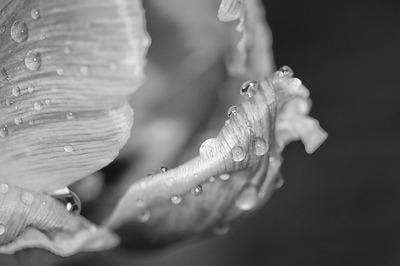I got up one morning last week and realized that it had just stopped raining. Everything was bathed in that nice, quiet light that comes when the storm ends and before the skies brighten when the clouds lift.
As I drank my morning coffee I connected a macro lens to my camera and placed a ring flash on the lens preparing to go out for some fun garden photography.
I like wandering in my wife’s garden with my camera just about any time – winter, spring, summer, or fall – each season has its own distinct visual character that is fun to photograph, but my favorite time is just after a rain.
I prefer using a longer focal length 200mm macro lens with a ring flash attached. I was fortunate enough to get a used one some years ago. I did not know what I was doing at the time. However, that ring flash went from what I thought was a gimmicky way to add light, to what I now consider an essential part of my lighting for plants when the ambient light is low or flat like on that wet morning.
Lighting small objects with a ring flash isn’t new to photographers, and ring flashes have had changing popularity during the years I have been involved in photography. Along with the amazing digital cameras we use, technology has brought new life into what was once pretty much left to biologists, naturalists, hard-core flower enthusiasts, etc.; as many photographers are now choosing ring flashes or ring flash modifiers for their macro work.
Canon has the MR-14 Ring Lite designed to surround the front of a Canon macro lens. Nikon has now moved away from the ring flash, but the two they offered for years, the SB29, and the older SB21b that I use, are easy to find used, and excellent to use. There is the Phoenix RL-59, the Cameron PRO DRF14 Macro Ring Flash, and Sigma’s EM-140 DG to name a few.
Also popular and economically priced are two that aren’t ring flashes, but are flash modifiers that attach to any flash converting the light output to that of a ring flash; the Ray flash and Orbis ring flash. The Ray Flash mounts to your camera with the flash attached on the hot shoe and the Orbis mounts from under your lens, with the flash stuck up inside it connected to the camera with an off-camera TTL cord.
Ring flashes produce perfectly even, shadowless images. I wouldn’t select that kind of lighting on a bright sunny day, but on overcast rainy days it’s an effective way to illuminate the water droplets balancing on flower petals and leaves.
I use mine on the “manual” setting, and reduce the light by adjusting the aperture until I get the sparkles to appear the way I want them. Then adding additional light from a flash keeps the shutter speed high to compensate for plant movement caused by an unwelcome breeze that might come up just when I‘m ready to press the shutter.
Using a tripod and a cable release will stop camera movement, but there are times when conditions are quickly changing and I want to photograph many subjects before the weather stops cooperating, and wind or rain drives me indoors. A ring flash allows me to do that.
For me garden photography is very relaxing and I like to take the time to look at each plant creatively. I also like to add light to the small, close-up subjects just as I would when taking someone’s portrait. That might mean using a reflector, or an off-camera flash, or as I have discussed above, with a ring flash, because it is really all about the quality of light that separates one image from another.
These are my thoughts for this week. Please don’t hesitate to contact me. Email your comments and suggestions to me at emcam@telus.net or phone 250-371-3069
John Enman owns and operates Enman’s Camera at 423 Tranquille Road in Kamloops, selling an interesting selection of used photographic equipment and offers professional wedding and event photography. Check out www.enmanscamera.com.
